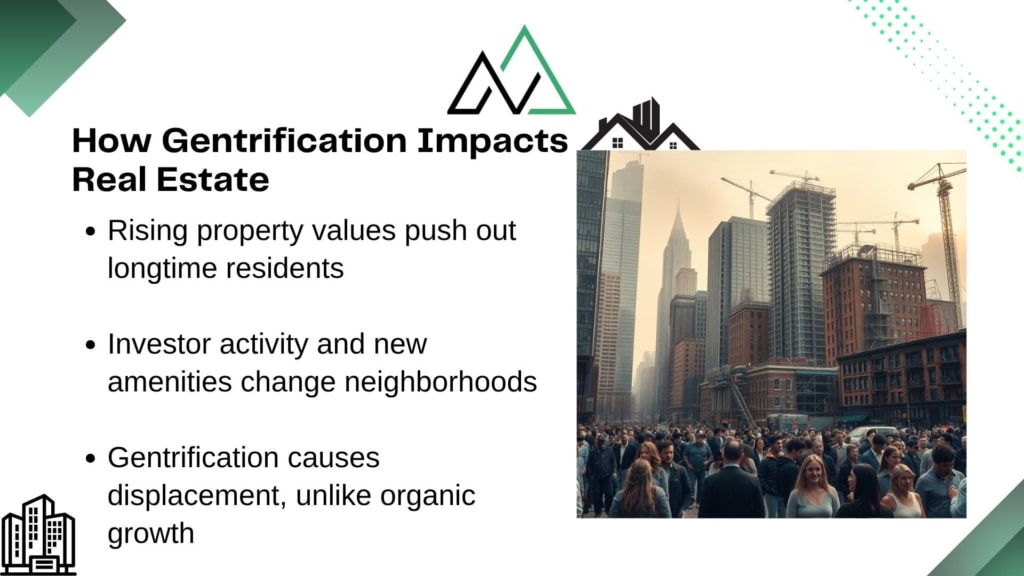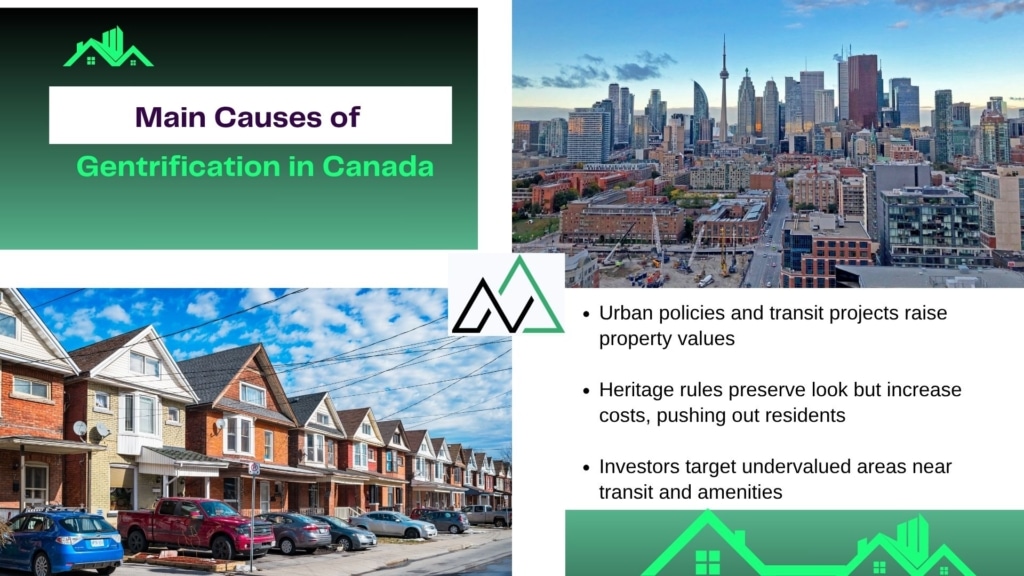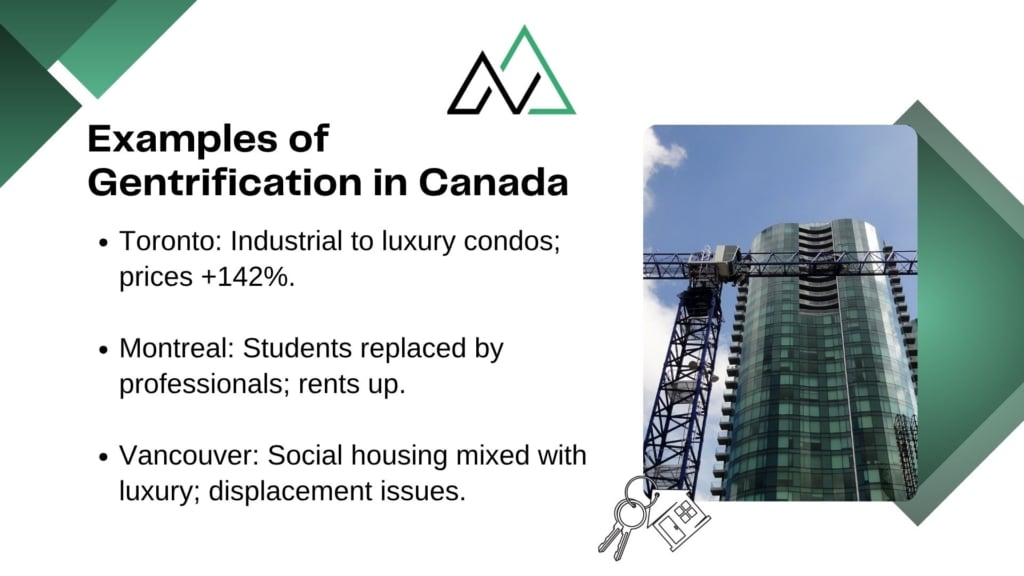In 1964, sociologist Ruth Glass first used the term “gentrification.” She described how working-class London neighborhoods changed when wealthier people moved in. Today, this change is happening in cities all over the world, including Canada’s biggest cities.
Gentrification means more money and different people coming into a neighborhood. This can make property values go up but can also push out long-time residents.
In Canada, cities like Vancouver and Toronto show what gentrification looks like. Vancouver’s Downtown Eastside used to be an industrial area but is now being revitalized. Yet, there are worries about keeping it affordable.
On the other hand, Toronto’s Parkdale area is seeing more condos but also efforts to keep its culture alive. These changes offer chances for buyers but also bring up tough social questions.
Knowing about gentrification helps investors and first-time buyers understand the market better. This guide will look at how gentrification works, its benefits for property, and the moral issues buyers should think about.
Key Takeaways
- Gentrification refers to neighborhood changes driven by wealthier residents and new investments.
- Ruth Glass’s original definition remains relevant to modern Canadian urban development.
- Vancouver and Toronto neighborhoods illustrate both economic opportunities and community challenges.
- Property value increases often accompany shifts in local demographics and businesses.
- Buyers should analyze long-term trends and social impacts when evaluating gentrifying areas.
Understanding Gentrification in Real Estate

Gentrification changes neighborhoods in big ways. It affects people living there, investors, and the city. To understand Canada’s housing market, knowing how gentrification works is key.
Defining the Process
Key Characteristics of Neighborhood Change
In places like Toronto’s West End, gentrification begins with small improvements. RE/MAX data shows homes there now sell 40% more than before. Three signs show this change:
- Rising property taxes outpacing longtime residents’ incomes
- New amenities catering to higher-income demographics
- Increased investor activity in previously overlooked areas
Historical Context in Canadian Cities
Urban policies have sped up gentrification in Canada for decades. Montreal’s Griffintown and Vancouver’s Yaletown turned from industrial to luxury areas. This shows a trend where cities focus on density over affordability.
How Gentrification Differs From Regular Development
Displacement vs. Organic Growth
Organic growth happens when new infrastructure helps current residents. But gentrification pushes out low-income families. A 2022 Toronto study found 15% of renters moved because of high renovation costs.
Economic vs. Cultural Shifts
Regular development might add a community center for locals. But gentrification brings in new businesses, changing the area’s feel. Vancouver’s Commercial Drive, once full of family shops, now has a mix of indie cafes and big chains.
Primary Causes of Gentrification in Canada

Gentrification in Canadian cities is not random. It’s caused by policy choices and market trends. These forces change neighborhoods, bringing both benefits and problems for locals and investors.
Urban Policy and Government Initiatives
Municipal governments are key players through land-use policies and infrastructure spending. For example, Calgary’s 2024 rezoning has led to quick changes in neighborhoods.
Transit-Oriented Development Projects
Upgrades to transportation systems often lead to gentrification. The Eglinton Crosstown LRT in Toronto shows how:
- Property values near stations go up
- New businesses move in
- The area’s demographics change
Heritage Preservation Efforts
In Montreal’s Plateau-Mont-Royal, preserving heritage has paradoxically sped up gentrification. Strict building rules:
- Keep the area’s look
- Make renovations expensive
- Push out low-income families
Market Forces Driving Neighborhood Change
The private sector boosts changes started by policies. Investors look for areas that are not yet popular.
Investor Activity in Undervalued Areas
Vancouver’s condo market shows how speculators find:
- Areas near future transit
- Unused commercial spaces
- Places where zoning can change
Shifting Demographics and Housing Demand
Millennials and downsizing baby boomers are changing housing markets. They want:
- Neighborhoods that are easy to walk around
- Places with shops and services
- Cultural spots
Canadian Examples of Gentrification Patterns

Canada’s cities show different gentrification patterns. These are influenced by local economies and government policies. Three cities highlight how gentrification varies across provinces:
Toronto’s West End Transformation
From Industrial Zones to Luxury Condos
Areas like Queen West, once industrial, now have glass condos. This change sped up after 2010. The city changed zoning rules, improved transit, and tech firms moved in.
- City rezoning allowed residential conversions
- Transit improvements increased accessibility
- Tech firms relocated headquarters nearby
Condo prices here rose 142% in a decade. This pushed out artists and small businesses. New buildings often have “art-inspired” designs but lack real creative spaces.
Montreal’s Plateau-Mont-Royal Evolution
Student Areas Becoming Professional Enclaves
Student numbers in this area dropped 33% from 2015. Professionals changed the housing market. Key changes include:
- Triplex conversions into single-family homes
- Cafés replacing dollar stores
- New co-working spaces in former artist studios
Griffintown’s warehouses now house tech workers, with rents doubling. Local protests led to some affordable units in new projects.
Vancouver’s Downtown Eastside Dynamics
Mixed-Use Development Pressures
This area is Canada’s most debated gentrification case. It combines social housing with luxury towers. Recent projects include:
- Ground-floor nonprofits beneath $3M penthouses
- Zoning exemptions for density bonuses
- Heritage façades preserving building shells
Community groups say these “hybrid” developments speed up displacement. Over 12 SRO hotels closed for condo conversions.
Impact on Canadian Homebuyers
Gentrification makes buying a home in Canada complex. It brings financial stress and new chances. Areas changing often have high costs for those living there now. But, they also offer great opportunities for smart investors.
Affordability Challenges in Transitioning Areas
Property taxes can surprise homeowners in areas changing fast. In places like Hamilton’s Barton Village, taxes went up 22% from 2019 to 2023. This is because of new buildings.
Renters also face big increases. A recent study found rent for 1-bedroom apartments went up 35% more than the average in these areas.
Rising Property Taxes and Living Costs
There are three main reasons for these affordability problems:
- Municipal reassessments after upgrades
- More demand from wealthier newcomers
- Changes in retail that favor high-end services
First-time buyers should plan to spend 15-20% more than the listed price. This is to cover extra costs like renovations or strata fees.
Long-Term Investment Opportunities
RE/MAX data shows homes in areas just starting to gentrify go up 50% faster than those in stable areas over 10 years. Smart buyers look for areas with three signs of growth:
Identifying Early-Stage Neighborhoods
1. Investments in transportation
2. Changes in zoning for mixed-use projects
3. More local business permits
Montreal’s Villeray area is a good example. Property values jumped 89% after the city improved the metro and relaxed zoning rules.
Benefits of Gentrified Neighborhoods
Gentrification is a topic of debate, but it brings real benefits to Canadian homebuyers. These areas see better infrastructure and economic growth. This creates unique chances for both residents and investors.
Improved Municipal Services
Gentrification leads to better community resources. Cities focus on areas showing economic growth. This means better parks, schools, and healthcare.
Enhanced Public Transportation Links
Toronto’s Regent Park shows the benefits of gentrification. After redevelopment, the area saw:
- A 40% drop in crime rates (2015-2022)
- New streetcar routes connecting to downtown
- 15-minute walkability scores improve by 62%
These changes make life easier and attract businesses.
Increased Property Values
Neighborhood upgrades boost housing markets. Vancouver’s Commercial Drive is a great example. Properties there gained 68% in value over five years, keeping the community feel.
Equity Growth
The “gentrification premium” helps build wealth. Homeowners in these areas see:
- Faster-than-average equity accumulation
- Stronger resale demand
- Rental income increases of 20-35%
Strategic buyers can benefit by entering early. But, timing is key.
Navigating Gentrification as a Homebuyer
Smart homebuyers see gentrification as both a chance and a duty in Canada’s changing markets. To make wise choices, you need tools to understand neighborhood shifts and stay ethical. Let’s look at three main strategies for balancing your financial goals with caring for the community.
Researching Municipal Development Plans
City plans show where gentrification might grow. Calgary’s blanket rezoning shows how policy changes can change neighborhoods fast. Homebuyer Jessie Davies avoided overpaying by studying these plans.
Accessing City Council Zoning Proposals
Here’s how to stay ahead of policy changes:
- Bookmark your city’s official planning portal
- Attend virtual council meetings (most Canadian cities stream them)
- Review infrastructure improvement maps
- Analyze proposed transit expansions
Working With Local Real Estate Experts
Specialized agents offer deep insights into gentrification challenges. Vancouver buyers used neighborhood analysis to spot retail developments 18 months early.
New Homes Alberta’s Neighborhood Analysis
This Calgary team mixes market data with community feelings. Their reports cover:
- Historic price patterns vs current valuations
- Upcoming municipal projects
- Local business expansion plans
Contact New Homes Alberta at (403) 305-9167
Get a free consultation to talk about ethical investments in changing areas. Their experts helped clients in Edmonton’s Boyle Street while keeping affordable housing.
Ethical Considerations in Transitioning Areas
True investment wisdom is knowing your impact on communities. Montreal’s Plateau district shows how to keep cultural identity as property values rise.
Balancing Investment and Community Impact
Ask these questions when looking at properties:
- What percentage of long-term residents remain?
- Are local services becoming inaccessible?
- How diverse are neighborhood demographics?
Conclusion
Understanding gentrification in real estate is key for Canadian buyers. It changes cities like Toronto’s West End and Vancouver’s Downtown Eastside. Rising property values and better services are good, but affordability is a big challenge.
Success comes from knowing the area and working with local experts. Companies like New Homes Alberta provide valuable insights. Viewing homes as community investments is wise.
Real estate choices in Canada improve with gentrification knowledge. Keeping an eye on infrastructure and zoning changes helps spot new areas. Making choices that benefit both your wallet and the community is important.
Staying updated with reliable sources helps buyers make smart moves. Whether looking for a first home or an investment, knowing about gentrification is essential. It turns complex urban changes into chances for growth.





